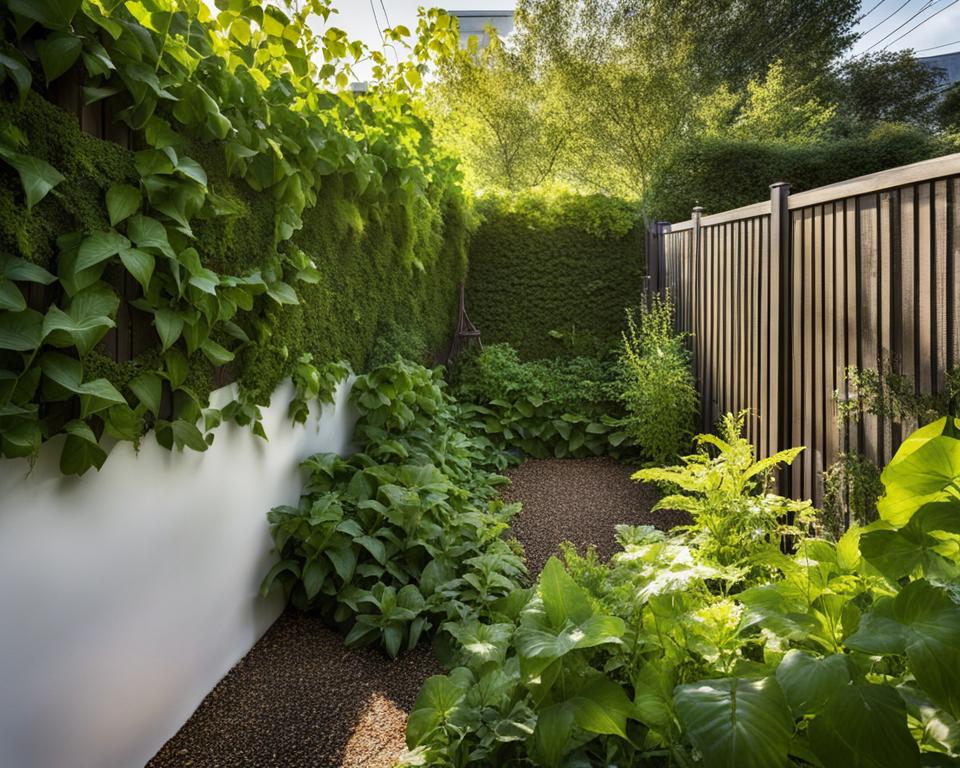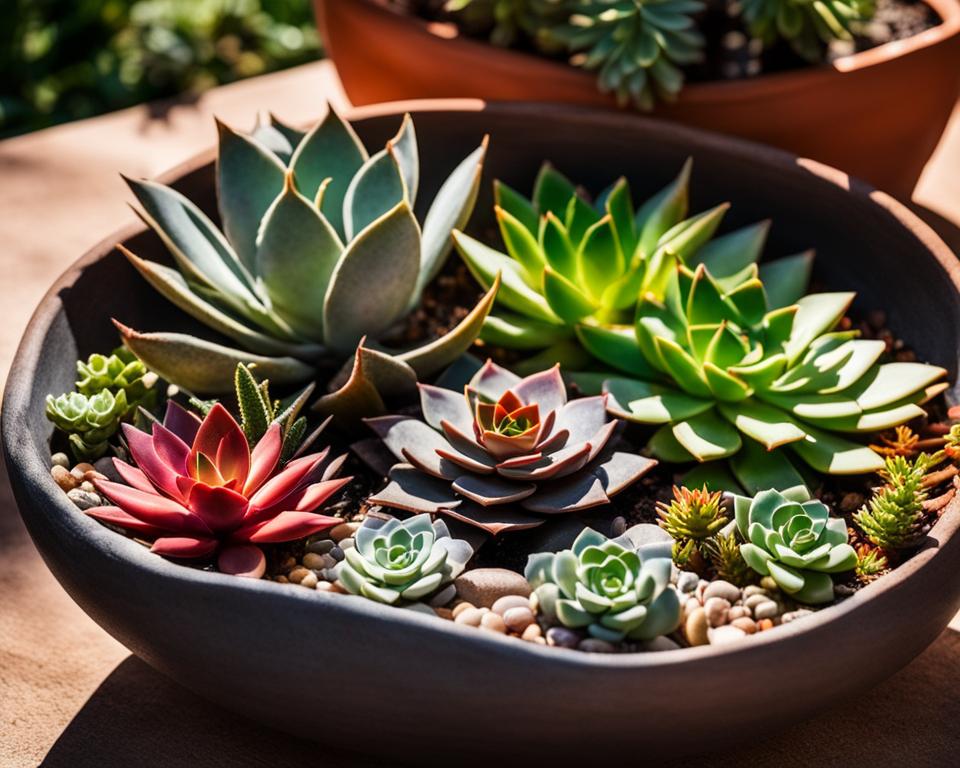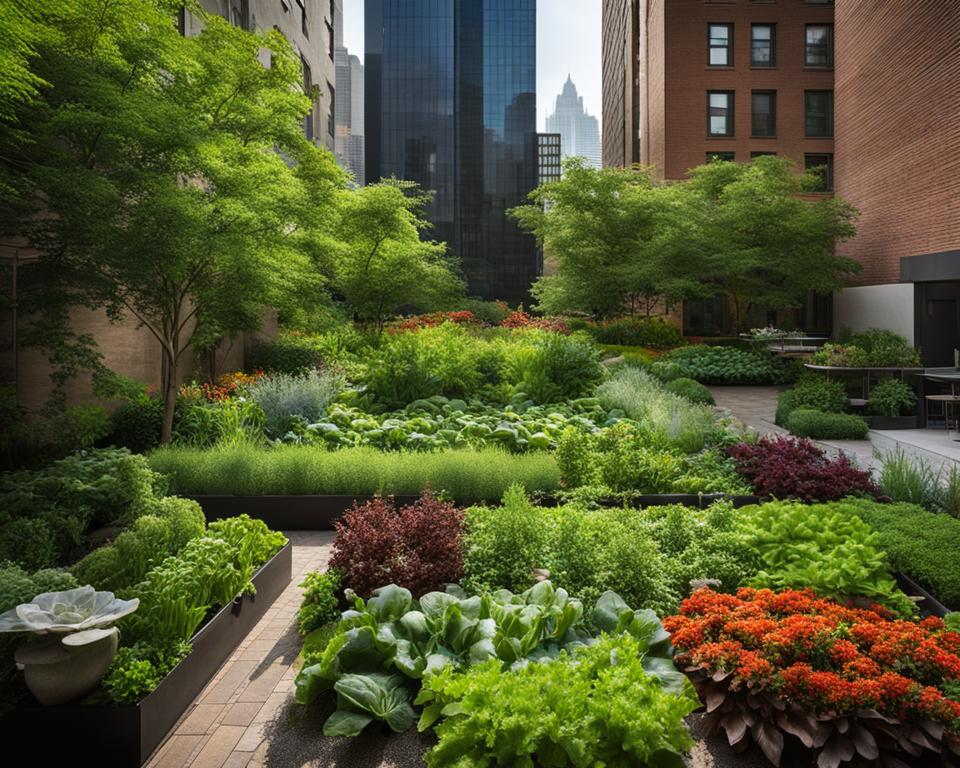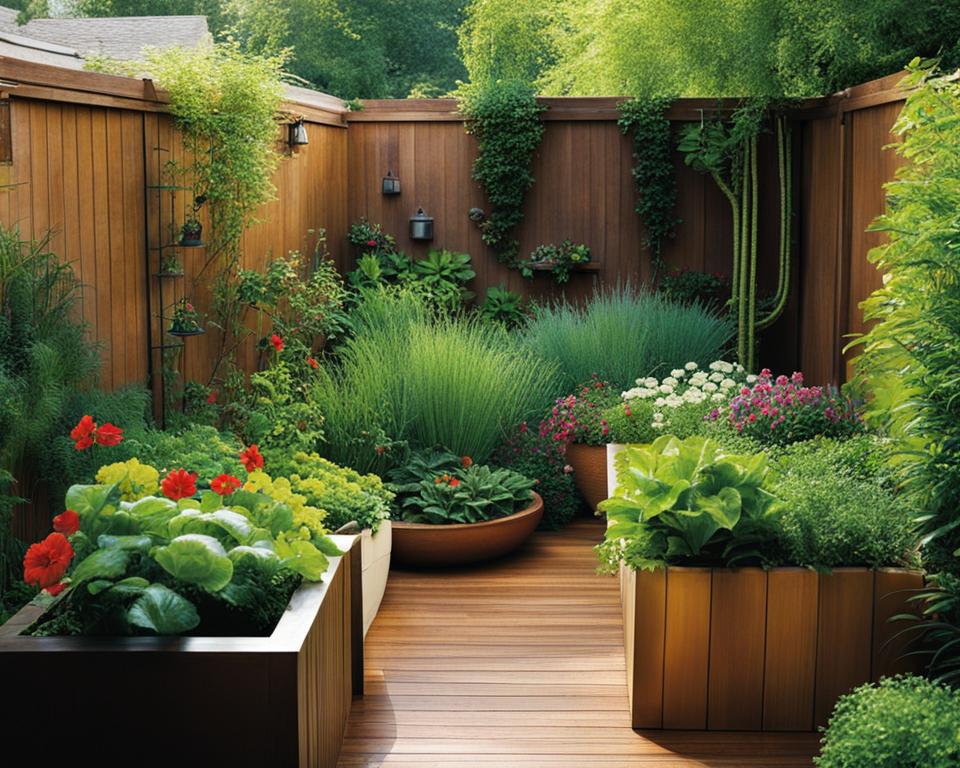Transform that cozy spot behind your house into a lush green world where nature thrives and peace resides. Yes, your backyard—no matter how compact—can burst into life with backyard urban gardening. With intuitive urban garden design, a little bit of effort, and the joy of digging into the earth, you can embrace organic gardening right where you are. Imagine stepping out to a balcony garden where plants nod in the breeze, a sanctuary you can call your own. Ready to turn your outdoor space into a green retreat? Learn how to plant the seeds of sustainability, one pot at a time, with these actionable urban gardening tips. Whether it’s your first time with your hands in the soil or if you’re a seasoned green thumb, elevate your space— and your spirit—through the enchanting world of sustainable gardening.
Key Takeaways
- Discover resilient and low-maintenance plants perfect for urban spaces.
- Utilize containers and vertical spaces to maximize greenery in compact areas.
- Learn about sustainable practices that help your garden and the environment thrive.
- Find organic solutions to cultivate your own produce, even with limited space.
- Embrace the holistic benefits of urban gardening for both mind and body wellness.
- Equip yourself with creative gardening hacks to build your urban oasis with ease.
Selecting the Right Plants for Your Urban Oasis
Embracing backyard urban gardening begins with choosing the right vegetation that not only resonates with your aesthetic preferences but also thrives in the unique conditions of urban farming. To make the most out of your outdoor sanctuary, consider plants that are not only easy to care for but also compatible with the urban environment’s challenges such as limited space, varying light conditions, and air quality. Let’s delve into some of the ideal plant choices for your small space gardening adventure.
Hardy Plant Varieties for Low-Maintenance Urban Gardens
For those seeking to cultivate a lush garden without the constant need for upkeep, several hardy plants stand out. These resilient varieties include coneflowers, yucca, and sedum—often known as “hens and chicks”. These species are well-adapted to urban conditions, requiring minimal attention yet offering maximum impact with their textural variety and vibrant hues.
Maximizing Small Spaces with the Best Flowers for Planters
To make the most out of compact spaces, selecting flowers well-suited for planters is key. Vibrant blooms like petunias and zinnias add a splash of color to any urban garden design and are known for their container-friendly growth habits. These flowers excel within the spatial constraints of urban settings and are easy to maintain, providing a continual display of beauty.
Edible Plants: Nutritional Additions to Your Backyard Urban Garden
Integrate nutrition and taste into your urban garden by incorporating edible plants. Compact herbs such as thyme, rosemary, basil, and sage can fit in the smallest of spaces and are indispensable for kitchen use. For those with a bit more room and sunlight, consider leafy greens and other vegetables like kale and chard, which are not as dependent on direct sun, thereby enhancing the utility and appeal of your urban oasis.
| Plant Type | Best for | Space Required | Maintenance Level |
|---|---|---|---|
| Petunias | Planters and Containers | Small | Low |
| Zinnias | Colorful Blooms | Medium | Low |
| Thyme | Culinary Use | Very Small | Low |
| Kale | Edible Greens | Medium | Medium |
Whether you seek to enhance your living space with lush foliage, bountiful blooms, or a source of homegrown sustenance, urban garden design offers a fulfilling way to reconnect with nature right in the heart of the city. With a bit of creativity and the right selection of plants, your urban garden will become a vibrant sanctuary adding life and flavor to your daily routine.
Container Gardening: Versatility for Urban Spaces
Unlock the potential of container gardening as a versatile solution for your urban garden design. When you’re challenged by the confines of high-rise living or a compact balcony, the flexibility of containers allows you to infuse greenery into your concrete surroundings. It’s not only about bringing beauty into your personal space; it’s about engaging in organic gardening and sustainable gardening practices that contribute to a healthier environment.
By incorporating vertical gardening techniques, you can transform the vertical spaces on your walls or rails into lush, edible gardens. Select containers and hanging baskets to make the most out of your patio or terrace, creating an array of green pockets full of your favorite herbs, vegetables, and flowers. Here’s a quick guide to help you get started:
- Choose the right container: Match the container size with the plant’s growth habits. Ensure sufficient room for root development.
- Quality soil: Opt for high-quality potting mix that provides a balanced environment for plant growth.
- Appropriate fertilizer: Use organic fertilizers to nourish your plants without introducing chemicals to your urban ecosystem.
- Water wisely: Recognize the watering needs of your plants and adjust accordingly to prevent over or underwatering.
| Container Type | Plant Examples | Benefits |
|---|---|---|
| Standard Pots | Basil, Tomatoes, Petunias | Wide availability, various designs |
| Window Boxes | Chives, Marigolds, Lettuce | Utilizes edge spaces, decorative |
| Hanging Baskets | Strawberries, Ferns, Nasturtiums | Maximizes overhead space, provides visual interest |
| Vertical Planters | Thyme, Succulents, Heuchera | Layers plants, saves floor space |
| Rail Planters | Lavender, Rosemary, Pansies | Adaptable to balcony rails, easy to install |
Container gardening is much more than simply finding a home for your plants; it’s about creating a living tapestry that weaves nature into your daily life. Whether you’re growing a simple selection of herbs or a full-scale vertical vegetable garden, the results can be remarkable. Get creative with your choices, and watch as your urban space transforms into a green sanctuary.
Remember, the heart of sustainable gardening is to make the most of what you have, and with containers, the possibilities are nearly endless.
The Beauty and Efficiency of Vertical Gardening

Imagine transforming the face of your urban dwelling into a vibrant tapestry of green. With vertical gardening, this vision is not only achievable, but it also respects the essence of urban garden design. In cityscapes where the horizontal is limited, the vertical becomes your canvas for cultivation. You’ll marvel at how a diverse array of edible plants in urban gardens can escape the confines of the ground and rise up towards the sky, offering bountiful harvests and eye-catching displays.
Sustainable gardening is about smart use of space and resources. Vertical arrangements allow you to grow more with less water, less soil, and less footprint, making organic gardening not only accessible but profoundly impactful. Whether you’re looking to start small with herbs or scale up to a living wall of salad greens, the principles of verticality can be your guide through the verdant world of upright horticulture.
Here’s where the rubber meets the road—or rather, where the plant meets the planter. Stack planters, which feature tiered compartments perfect for a variety of plant species, can create a striking multi-level effect. Railing planters utilize otherwise-unused balcony edges, offering you a parade of blossoms or herbs right at your fingertips. Moreover, hanging baskets serve as sky-bound pods for your botanicals, embracing both beauty and utility in each gravity-defying cluster.
| Vertical Planter Type | Recommended Plants | Benefits |
|---|---|---|
| Stack Planters | Succulents, Strawberries, Ornamental Grasses | Creates height, saves floor space, ideal for mixed plantings |
| Railing Planters | Herbs, Ferns, Begonias | Utilizes unused spaces, easy to maintain at waist height |
| Vertical Wall Planters | Air Plants, Ivy, Edible Greens | Transforms walls into eco-friendly art, perfect for air purification |
| Hanging Baskets | Petunias, Cherry Tomatoes, Lobelias | Offers 360-degree sunlight exposure, enhances overhead aesthetics |
Donning the hat of an urban agriculturist, you’re not just planting; you’re architecting ecosystems in the air. As the world tilts towards denser populations and less green space, vertical gardening stands out as more than a trend—it’s the cornerstone of a sustainable urban living philosophy that cherishes every leaf, every bud, and every possibility.
Enhancing Privacy with Plants in Your Outdoor Area

Creating a sense of seclusion in your urban abode isn’t just about fences and walls—it’s about softening those lines with greenery that not only shields but beautifies. Whether your outdoor area is a small balcony or a compact courtyard, the strategic use of plants can offer you the privacy you crave while contributing to sustainable gardening practices.
Climbers and Vines: Natural Screens for Seclusion
You’ve seen them in romantic films and cozy neighborhoods, those lush green walls that seem to whisper secrets of hidden gardens. Climbers and vines can create similar enchantment and intimacy for your own urban space. Imagine a trellis covered in flowering clematis or sweet-smelling jasmine that creates a living curtain between your space and the world beyond. Consider how vertical gardening with these climbers can maximize your small space gardening aspirations.
The Role of Exotic Vines in Urban Garden Design
For those looking to add an exotic touch, passion flower vines offer more than just a visual feast. They become the centerpiece of conversation and curiosity, introducing an element of unique beauty to your urban garden design. Beyond their ornamental value, these climbers serve a dual purpose. They act as privacy screens while utilizing the vertical space of your garden, and many yield edible fruits, aligning with the principles of organic gardening by bringing food production to your doorsteps.
| Vine Species | Screening Effectiveness | Edible Yield |
|---|---|---|
| Passion Flower | High | Gourds, Passion Fruit |
| Ivy | High | None |
| Honeysuckle | Medium | Berries |
| Jasmine | Medium | None |
Whether you’re looking to screen your garden from prying eyes, or simply want to add a vertical element to your small space, the integration of vines can not only fulfill these desires but also contribute to sustainable gardening within the urban environment.
Crafting a Succulent Bowl for Eye-Catching Centerpieces

Backyard urban gardening has become a sanctuary for those looking to bring a slice of nature into their home environments. Small space gardening enthusiasts and aficionados of urban garden design are increasingly turning to succulent bowls as captivating, low-maintenance centerpieces that exemplify the essence of organic gardening.
Whether you’re a seasoned gardener or new to the green scene, creating a succulent bowl is an enjoyable and artful way to enhance your living space. These miniature landscapes encapsulate sustainable gardening principles, requiring minimal watering while offering a lush visual appeal.
Before you begin, consider the variety of succulents available. With their diverse colors, shapes, and sizes, selecting the right combination can add texture and depth to your arrangement. Here’s how to create your very own succulent centerpiece:
- Choose a wide, shallow bowl.
- Fill the base with a layer of pebbles for drainage.
- Add a mix of cactus soil and potting mix.
- Arrange your succulents, grouping similar shapes or colors.
- Top with gravel, aquarium stone, or decorative moss for a polished look.
- Water sparingly, allowing the soil to dry between watering.
For those who revel in the details, a carefully curated succulent bowl can become more than just décor; it’s a reflection of your personal taste and commitment to greener living, even in tight quarters.
| Succulent Type | Color | Light Requirements | Water Requirements |
|---|---|---|---|
| Echeveria | Green, Blue, Purple | Bright, indirect light | Allow soil to dry between watering |
| Sempervivum | Green, Red, Purple | Full sun to partial shade | Low water; tolerate drought |
| Haworthia | Green with white patterns | Bright, indirect light | Water when soil is dry |
| Sedum | Green, Yellow, Red | Full sun to light shade | Sparingly during the growing season |
Succulent bowls require minimal effort to maintain and are a testament to the ease and beauty of small space gardening. The seamless fusion of function and form makes these elegant arrangements a centerpiece that captures and holds attention, delivering a powerful statement in the world of organic gardening and sustainable gardening practices.
Backyard Urban Gardening with Flavorful Herbs and Vegetables

As you cultivate your own slice of nature in the heart of the city, consider the bountiful benefits of integrating both herb gardens and vegetables into your urban green space. Not only do they elevate your culinary experiences with fresh, organic ingredients, but they also enhance your connection to the environment through sustainable gardening practices.
Imagine stepping outside your back door to a vibrant display of edible plants in your urban garden—fresh salad greens, ripe tomatoes, and crisp peppers awaiting your harvest. With some basic urban gardening tips, it’s possible to nurture these delights, even in a compact space.
Herb Gardens: Fresh Seasonings at Your Fingertips
Embark on an aromatic adventure with your own herb garden. Herbs like thyme, rosemary, basil, and sage require minimal space and can be easily grown in small containers. These versatile plants can be used in a myriad of dishes, providing fresh seasonings at your fingertips. Plus, they contribute to organic gardening by relying less on packaged goods and more on what you can grow yourself.
Urban Vegetable Gardening: From Garden to Table
Why stop at herbs when you can expand your backyard urban garden to include a variety of vegetables? With suitable sunlight exposure, growing vegetables such as salad greens, tomatoes, and peppers enrich your meals with flavor and nutrition. They’re not only edible plants but also key players in your garden’s ecological balance, attracting pollinators and contributing to biodiversity.
- Ensure each plant receives the optimal six to eight hours of direct sunlight daily.
- Choose containers that allow enough room for growth and provide adequate drainage.
- Regularly water and fertilize your plants to promote a bountiful harvest.
Your urban space can become a testament to the flavors of nature, redefining the essence of what it means to prepare a meal with ingredients nurtured by your own hands.
Water Wise: Efficient Irrigation and Moisture Management
As a backyard urban gardener, one of the smartest things you can do to enhance your green haven is to master efficient irrigation and moisture management. The lifeblood of sustainable gardening is ensuring that your precious plants receive just the right amount of water—striking a perfect balance that prevents both oversaturation and drought.
Before diving into our in-depth tips, consider the importance of vigilance in water management. Vigilantly guard against over and under-watering to prevent root rot and dehydration. With consistent and mindful watering practices, you’re not only sustaining plant life, but also contributing to a more sustainable environment overall.
Innovative Watering Strategies for Urban Gardens
Your approach to urban gardening should be as unique as your space. With vertical gardening, traditional methods take on a new dimension. Stack planters and green walls benefit greatly from self-watering systems or drip irrigation setups that deliver water directly to the roots with minimal waste.
For your classic containers on patios and balconies, try water-retaining crystals or granules that slowly release moisture. These can be life-savers if you’re dealing with a reflective heat environment or you often travel, leaving your plants unattended for days at a time.
Protect Your Plants from Over and Under Watering
Thorough watering practices combined with proper drainage are the foundations of good moisture management. A well-draining soil mix is a must-have, as it ensures that water reaches the roots but doesn’t allow them to stew in moisture, which could cause diseases.
| Plant Types | Watering Needs | Heat Tolerance | Recommended Actions |
|---|---|---|---|
| Succulents | Minimal; sensitive to over-watering | High | Use well-draining soil; water deeply but infrequently |
| Leafy Greens | Moderate; even moisture is key | Moderate | Install a drip irrigation system; mulch to retain moisture |
| Herbs | Varies by type; generally low to moderate | Mostly high | Feel the soil; water when top inch is dry |
Remember, for areas that experience high temperatures, such as sun-drenched balconies, opting for drought-tolerant plants like succulents is not only an efficient choice but a stylish one as well.
Sustainable Gardening Practices for the Environmentally Conscious
As an environmentally conscious individual, you have the power to make significant positive impacts through sustainable gardening. By adopting practices like composting urban gardening and organic gardening, you not only contribute to environmental conservation but also cultivate a healthy ecosystem right in your backyard urban garden. Let’s explore how you can integrate eco-friendly techniques into your daily gardening routine to benefit both the planet and your pocket.
Using Compost and Mulch for Soil Health
Introducing organic compost is a crucial step towards nurturing soil health in your urban garden design. Compost is teeming with beneficial microorganisms that enrich the soil and support plant growth. In addition, applying a layer of mulch conserves moisture, suppresses weeds, and keeps soil temperatures stable. These practices ensure your garden is both flourishing and eco-friendly.
Harvesting Rainwater: Saving the Environment and Your Water Bill
To truly embrace eco-conscious gardening, consider harvesting rainwater. Simple solutions like rain barrels effortlessly capture and store rainwater for future use, drastically reducing your dependency on municipal supplies and lowering your water bill. If you’re interested in recycling wastewater, a filtration system like Big Berkey can safely purify and repurpose household wastewater for garden irrigation. Harnessing these natural resources creates a sustainable cycle of resource usage, setting a benchmark for sustainable gardening practices.
Through these strategic choices, you can create not only a beautiful urban retreat but also a model for ecological stewardship. So, roll up your sleeves and make your green thumb count for the environment.
Conclusion
As you delve into the art of backyard urban gardening, remember that each plant, container, and drop of water contributes to a much larger tapestry of sustainable gardening. Your urban oasis is more than just an aesthetic delight—it’s a testament to the balance one can achieve through organic and sustainable practices. Embrace this lifestyle as a journey that not only transforms your living space but also enhances your connection to the environment and your community.
Final Thoughts: Embracing the Urban Gardening Lifestyle
The vibrant lifestyle of urban gardening complements the dynamic rhythm of city living. By adopting small space gardening techniques, you’ve embraced a world where every square inch of space can flourish with life. Let these urban gardening tips be the foundation upon which you can build a personalized green retreat, one that nurtures both your well-being and the planet’s health.
Growing Forward: Expanding Your Green Space Knowledge
Your gardening journey is as evergreen as the plants you nurture: there is always room to grow. Venture beyond the basics and continue to enrich your understanding of urban farming and green space cultivation. Tailoring your approach to suit your unique surroundings, comprehending the myriad ecological benefits each plant presents, and mingling with fellow gardening enthusiasts are invaluable steps. They enhance not only your personal garden but also contribute greatly to the urban landscape at large.
FAQ
What are the best low-maintenance plants for my urban garden?
Hardy plant varieties like coneflowers, yucca, hens and chicks, petunias, zinnias, and daylilies are great low-maintenance options that can thrive in urban garden settings, providing you with beauty and resilience.
How can I maximize my small urban gardening space?
Embrace container gardening and vertical gardening to utilize all available space efficiently. Use containers for flexibility and install vertical structures like wall planters and hanging baskets to grow plants upwards. Choose flowers like petunias and zinnias for containers, which bloom beautifully in limited space.
What edible plants can I grow in my urban garden?
Herbs are a great starting point—they’re compact and can be easily grown in small spaces or containers. Thyme, rosemary, basil, and sage provide fresh flavors for cooking. For vegetable gardening, consider growing salad greens, tomatoes, and peppers, which can thrive with six to eight hours of sunlight.
Can I design my urban garden for privacy?
Absolutely, integrating climbers and vines like ivy, honeysuckle, and jasmine can create natural screens that enhance privacy while adding aesthetic value. If you’re looking for something more exotic, passion flower vines not only offer privacy but also produce edible fruits.
What are some creative centerpiece ideas for my urban garden?
A succulent bowl is an excellent choice for a low-maintenance, stylish centerpiece. It can host a variety of succulent species, only needs minimal watering, and can be decorated with gravel or aquarium stone for added texture and color.
How do I ensure my urban garden is adequately watered?
Innovative watering strategies like self-watering containers and water-releasing crystals can help maintain moisture levels. It’s also important to protect your plants from over and under-watering through thorough watering methods and proper drainage. Consider drought-resistant plants for areas with intense heat.
How can I practice sustainable gardening in an urban environment?
Utilizing compost and mulch can greatly improve soil health and water retention, leading to a more sustainable garden ecosystem. Additionally, you can harvest rainwater for irrigation to conserve resources and reduce your water bill. Look into systems that allow safe reuse of household wastewater as well.
What steps can I take to expand my knowledge and make the most of urban gardening?
Continuously educate yourself on green space cultivation, understand the ecological benefits of your plant choices, and engage with the urban gardening community. Adapting your gardening practices to match your unique urban living conditions is key to creating a thriving garden.

